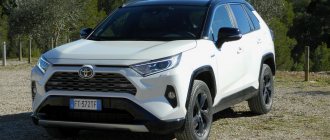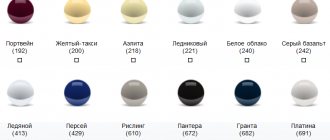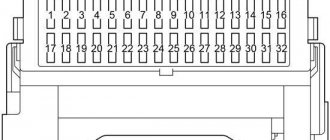Toyota: reviews and tests of Toyota RAV4 April 16, 2013
Toyota RAV4 is a fairly popular crossover. Moreover, from generation to generation (there have been 4 in total since 1994, if we count the generation of 2013), this popularity does not decrease at all.
The latest version of the Rav 4 was presented at the Los Angeles Auto Show in November 2012, and traditionally attracted a lot of attention. It is worth noting that the car, compared to the third generation Rav 4, has undergone dramatic changes. Some of them benefited the car, but the same cannot be said about others.
As for the appearance of the new generation of the car, it has changed quite seriously compared to previous versions. The new Toyota RAV4 received smoother lines, an ergonomic interior and advanced electronics.
In Russia, dealers have been accepting orders for this car since February 2013; Russian prices for the RAV 4 2013 start at 998,000 rubles for the “Standard” package.
Exterior and overall dimensions of Toyota RAV4 2013
It is worth noting that in the appearance of this car one can discern details very similar to elements of other cars of this concern. So the headlights of the RAV4 are made in the style of the new Camry line. The rear spoiler of the car turned out to be exactly the same in appearance as that of the Highlander.
The radiator grille gives the car a more “smiling” appearance. The rear optics have also changed radically. It is strikingly different from the one installed on previous generations.
As for the dimensions, the length and width of the crossover have increased slightly compared to its predecessors. But this did not at all affect the spaciousness of the cabin; it even seems that it has become somewhat smaller. By the way, the fourth generation of RAV4 lost the long-wheelbase version.
This may not play well on the popularity of this car among lovers of space and comfort (although manufacturers claim that in previous generations, long-shaped versions were not particularly popular).
If we look at the overall dimensions of the new Toyota in more detail, they are as follows:
— length 4,569 mm (124 mm more than its predecessor);
— width 1844 mm (29 mm more);
— the height of the car became slightly lower (by 24 mm) than in previous versions of the car and amounted to 1661 mm.
As for the ground clearance, the version intended for Russia is 197 mm, which is as much as 37 mm more than that of the “Americans”.
Appearance
One of the advantages of the crossover is its transformed appearance; the 2013 RAV4 model year is radically different from its older brothers. The front of the car is made in a new style; the striking elements are narrow headlights and a two-component bumper with complex terrain. The back door has not only changed in appearance, but also received a new opening mechanism; now it rises up.
Undoubtedly, everyone will like the new product, regardless of gender, age and social status. The body is made from several lightweight types of steel, which reduces the weight of the car, which helps improve aerodynamic characteristics.
Interior and comfort of Toyota RAV4
The new generation salon has also undergone quite serious changes. This affected, first of all, design and ergonomics. The design has become more modern and “advanced”, and the controls have become more rational and thoughtful. As an example, we can note the controls for the climate system - small and not very convenient buttons are now replaced with “twisters”.
But as far as the quality of the interior is concerned, one would generally expect better from a new car. The interior is full of hard plastic, which is even found on the car door handles. Only small areas are made of soft plastic (this part includes the center console armrest, as well as some protruding parts of the panel).
Previous versions of the RAV4 attracted motorists with the convenient transformation of the second row seats and the ability to move them along the guides. This version does not have this - the maximum that can be done here is to fold the rear seat backs. And even then this is done extremely inconveniently, since it is very difficult to get to the levers that allow you to fold the backrests.
Based on this design, even though on paper the maximum trunk volume has increased, for some reason this is not observed in practice. By the way, as for the trunk, its lid now opens upward, and not to the side, as was the case with the predecessors of this generation. It is worth noting that the spare tire has also “changed its place of residence.” Now it is located under the trunk, and not in it.
The sound insulation of the interior of the new generation Toyota RAV4 has improved somewhat. However, it was still not possible to relieve the driver and passengers from the barely audible rustle of tires and the rumbling of the engine (especially during intense acceleration). Already at a speed of 70 - 80 km/h you can hear the tires making noise.
Some car owners, judging by the first reviews of the 2013 Toyota RAV4, also have complaints about the interior: the interior is tighter than competitors in the same class, the driver would like to lower the steering wheel, but the steering column interferes with the legs when getting out and in.
In addition, the driver's seat is set quite low, and the glass line, on the contrary, is high, and this does not allow the seat to be adjusted to a “command position”. There is enough headroom, but it is impossible to raise the seat higher. The longitudinal margin is large for both the driver and the passengers in the back seat, but the problem of visibility for the rear passengers is even more pronounced than for the driver, since their seats are completely “recessed”. The reason for this is the fashionable obstruction of the lowered roof, which simply did not allow making a different arrangement.
New for the 2013 Toyota RAV4 is a lifting rear door instead of a hinged one and no spare wheel on it. The wheel “moved” into the trunk, where it was covered with a hefty podium, which raises the floor above the door parting line, which is why when opening the back door, small things can fall out of the trunk.
Security systems
The basic equipment is rich in electronic safety systems: the “standard” equipment includes an anti-lock braking system (ABS), an emergency braking system (BA), an electronic brake force distribution system (EBD), an anti-slip system (ASR), a motion stabilization system (ESP), and also two front and side airbags for the driver and passenger, a driver's knee airbag and two side curtain airbags.
Suspension
The car's suspension has not undergone any special design changes. As before, it is independent at the front, made according to the MacPherson system, and at the rear it is independent with double wishbones and stabilizers. But as for the setup of the new version of RAV4, it is made more efficiently and thoughtfully. As a result, the suspension turned out to be more energy-intensive compared to its predecessors. However, when driving over serious bumps, the rear passengers still get a fair shake.
In practice, this resulted in a slightly softer, more relaxed ride, smoothing over potholes and smoothing out road imperfections. The chassis has become stiffer, and the steering has been supplemented with electric power steering with new, more precise settings. In principle, nothing super unusual, but for its class the suspension settings are not bad. Nevertheless, the main complaints of the first buyers are about the overly stiff rear suspension, which throws up the rear and thumps on speed bumps and in deep holes. It is especially unpleasant that this effect cannot be adjusted or removed in any way.
Advantages and disadvantages
The first months of using the car revealed its advantages compared to the previous version.
The owners consider the main advantage of the updated performance characteristics of the RAV4 to be a significant improvement in engine performance. The improved power unit allowed the SUV to improve its dynamic characteristics. Fuel consumption has not increased.
The modified body with an increased wheelbase has become more stable on the road. Increased ground clearance and reduced front overhangs of the car improved cross-country ability. The improved suspension made overcoming obstacles smoother. The luggage compartment of the SUV has increased significantly.
The appearance of the car has improved, it has become more brutal. The body has become more angular with sharply prominent edges. The SUV received improved diode optics.
The quality of the interior has improved. The interior is decorated with soft, wear-resistant plastic that is pleasant to the touch. The leather used for interior trim has become smoother and more elastic, resistant to dirt.
When purchasing a car, owners hoped that automakers would eliminate the shortcomings inherent in earlier versions.
It remains in the new version. This was especially felt by fans of fast and dynamic driving. At speeds over 120 km/h, the noise increases and the rear view mirrors and roof rails begin to “sound”.
During the advertising campaign, the developers, in the description of the new version, promised a significant reduction in fuel consumption due to an improved gasoline engine. In practice, no reduction in consumption is observed. Gasoline consumption data remained at the same level.
Among the shortcomings is the lack of a full-size spare wheel on the SUV.
Owners do not have completely negative opinions about the new release of RAV4. The advantages of the new model in all respects more than cover the minor disadvantages.
Engine, transmission, dynamics and more...
The car can be manufactured with a 2 or 2.5-liter gasoline power unit, or with a 2.2-liter diesel engine. With a 2-liter gasoline unit, a 6-speed manual, 6-speed automatic, or continuously variable transmission can be used. The 2.5-liter petrol and diesel engines are only paired with a 6-speed automatic transmission.
All engines offered for any modifications of the Toyota RAV4 are quite economical: - for a 2.0 liter petrol engine. consumption on the highway is 6.5 liters, in city mode - about 10 liters, and in mixed mode - 8 liters. The gasoline recommended by the manufacturer is AI-92. At the same time, this engine produces a maximum speed of around 180 km/h, and the car accelerates from 0 to 100 km/h in just 10.2 seconds. This engine is equipped with a manual transmission and a CVT, and is available in all-wheel drive and front-wheel drive variations;
— for a 2.5-liter gasoline engine, consumption increases slightly and is: on the highway — 6.8 liters, in city mode — 11.4 liters, and in mixed mode — 8.5 liters. But the acceleration speed is significantly reduced - to 9.4 seconds, although the maximum speed remains the same - 180 km/h. A gasoline engine of this size comes with only an automatic transmission and only all-wheel drive;
- diesel is even more economical - in mixed mode it consumes 6.5 liters. The RAV4 with a diesel engine accelerates from 0 to 100 km/h in 10 seconds, and can reach a maximum speed of about 185 km/h. It is equipped only with an automatic transmission and an all-wheel drive system.
The driver has three control modes at his disposal, which regulate engine response, steering sensitivity and gearbox ratios - eco-friendly, normal and sport. The “sport” mode implies maximum dynamism, the eco mode - maximum fuel economy. When traveling around the city, the eco-friendly mode is practically inapplicable - in this mode, the car is delayed, as if reluctantly responding to the driver’s demands, and therefore is quite annoying during frequent stops and sudden starts at traffic lights.
However, since Toyota is a recognized leader in the use of the latest technologies in the production of cars that can improve fuel efficiency and reduce CO2 emissions, the car remains quite environmentally friendly in any other modes.
As in previous generations, there is both front- and all-wheel drive options. It is worth noting that due to the use of a special system, rear-wheel drive is automatically connected only as needed, so we can talk about some fuel savings (although in this matter the RAV4 is clearly inferior to its “classmates” from Honda and Ford).
Price
There are quite a lot of configurations, but choosing the right one will not be difficult. The main differences are due to the presence of three types of engines (two gasoline, 2.0 and 2.5 liters and 146 and 180 hp, respectively, and diesel (2.2 liters and 150 hp)), all possible transmission options transmissions (6-speed manual, 6-speed automatic and ultra-modern continuously variable variator Multidrive S, which was not previously available for front-wheel drive trim levels).
The new generation Toyota RAV4 is available in 8 different trim levels. For 998,000 rubles you can become the owner of a car in the “Standard” configuration. For this price the car enthusiast will receive:
— 2 front and side airbags, 2 curtain airbags and a knee airbag for the driver;
— a full set of “tricky” systems, such as ABS, EBD, TRC, BAS, uphill start assist system and downhill assist system, integrated active control system, etc.;
— air conditioning and many other useful elements (full-size spare wheel, PTF, LED running lights, etc.).
The most expensive version of the car is the Prestige Plus package. For this pleasure you will have to pay 1,543,000 rubles. For this money, in addition to all the delights, the car enthusiast will receive a navigation system with HDD, lane change warning systems, light switching and blind spot monitoring. Also included in this configuration are roof rails on the car's roof.
Options and prices Toyota RAV4 2013 in Russia
| Equipment | Price, rub | Engine | Transmission | type of drive | Acceleration to 100 km/h, s | Consumption city/highway, l | Maximum speed, km/h |
| 2.0 (4WD) manual transmission Comfort | 1 180 000 | gasoline 2.0l (145 hp) | Mechanics | full | 10,7 | 10,0 / 6,4 | 180 |
| 2.0 (4WD) Automatic Standard | 1 135 000 | gasoline 2.0l (145 hp) | machine | full | 11,3 | 9,4 / 6,3 | 180 |
| 2.0 (4WD) automatic transmission Comfort+ | 1 248 000 | gasoline 2.0l (145 hp) | machine | full | 11,3 | 9,4 / 6,3 | 180 |
| 2.0 (4WD) automatic transmission Elegance | 1 355 000 | gasoline 2.0l (145 hp) | machine | full | 11,3 | 9,4 / 6,3 | 180 |
| 2.0 (4WD) automatic transmission Prestige | 1 438 000 | gasoline 2.0l (145 hp) | machine | full | 11,3 | 9,4 / 6,3 | 180 |
| 2.0 (FWD) Manual Transmission Standard | 998 000 | gasoline 2.0l (145 hp) | Mechanics | front | 10,2 | n/a / n/a | 180 |
| 2.0 (FWD) automatic transmission Sandart + | 1 055 000 | gasoline 2.0l (145 hp) | machine | front | 11,1 | n/a / n/a | 180 |
| 2.2 D automatic transmission Elegance | 1 460 000 | diesel 2.2l (149 hp) | machine | full | 10,0 | n/a / n/a | 185 |
| 2.2 D automatic transmission Prestige | 1 533 000 | diesel 2.2l (149 hp) | machine | full | 10,0 | n/a / n/a | 185 |
| 2.5 automatic transmission Elegance+ | 1 470 000 | gasoline 2.5l (179 hp) | machine | full | 9,4 | 11,4 / 6,8 | 180 |
| 2.5 automatic transmission Prestige+ | 1 543 000 | gasoline 2.5l (179 hp) | machine | full | 9,4 | 11,4 / 6,8 | 180 |
Factors that influenced the increase in size and weight of the Toyota RAV4
There are several of them. Let's list the main ones.
Platform.
Its dimensions and weight largely depend on the architecture of the car. The base of the first generation models carried less load. Over time, the number of systems and various technical devices in cars has increased. This is noticeable in the arsenal of RAV4 configurations; it expanded with each new generation. It was necessary to use a new “trolley” that could withstand such loads. The platform for the first generation three-door car was borrowed from the leader of the Japanese corporation - Corolla. Now the basis for the new RAV4 is the family TNGA-K architecture, modernized for the brand’s flagship. It should be noted that despite the increase in size, the weight of the crossover has not increased. The use of lightweight materials had an effect: aluminum alloys. This helps improve the aerodynamic qualities of the car and reduce fuel costs. Less weight allows you to quickly gain the desired speed and improve acceleration time to 100 km/h.
Body parts.
Leading car manufacturers are trying to get ahead of their competitors in the fight for the best positions in the popularity ratings of potential buyers. To achieve this, Toyota Motor Corporation developers are inventing new forms, trying to improve aerodynamic qualities and make the RAV4 exterior attractive. As a result, a change in the overall parameters of the car.
Various little things. Pleasant and not so pleasant...
Many owners of the new 2013 RAV4 are upset by some little things that cost a penny, but are missing from the car:
— no front parking sensors even in the maximum configuration (except for plus models),
— there is no illumination of the buttons for opening windows and opening doors (issue price – 70 rubles),
— imitation stitching goes right on plastic (even synthetics are spared, not to mention leather).
— all-wheel drive and rear door control buttons are hidden from the driver behind the wheel
— the left wiper stops far from the A-pillar and leaves a dirty strip about five centimeters wide
- the exhaust pipe of the exhaust system is low under the engine (so that the ground clearance in this place is reduced to 160 - 170 mm, and this, strictly speaking, is not at all suitable for a crossover) and so on.
But despite all the shortcomings and the rumbling rear suspension, the car has already gathered enough fans, including those who moved to it from previous versions of the RAV4. Overall, it makes a pleasant impression and is not without its merits, but it leaves a feeling of incompleteness and haste. Judging by the reviews, new owners of the Toyota Rav 4 2013 are attracted, in addition to the car itself, by the reputation of the manufacturer and Toyota service, available in almost every corner of the country.
Reviews
Reviews and tests
Overall size and weight of Toyota RAV4 in all generations
To begin with, we present a table that shows all the dimensions, weight of the crossover, as well as the ground clearance in modifications of various generations.
| Modification | Dimensions: (mm) Length x | Ground clearance (mm) | Curb weight ( kg ) |
| I generation. Body XA 10, 3-door version. Engine 2.0 l. MT and AT, 4WD and front-wheel drive. Start of production: 1994 | 3,705 x 1,695 x 1,655 | 200 | 1 150/1 565 |
| XA10, 5-door, 2.0 l. MT and AT, 4 WD and front wheel drive. 1995 | 4,115 x 1,695 x 1,660 | 200 | 1 325/1 755 |
| XA10 convertible. 2.0 l. MT and AT, 4WD. 1997 | 3,705 x 1,695 x 1,655 | 205 | 1 265/1 630 |
| II generation. Body XA20, 5 doors, 1.8 and 2.0 l, MT and AT, 4 WD and front-wheel drive. 2000 | 4,200 x 1,735 x 1,680 | 190 | 1 275/1 825 |
| XA20, 3 doors, 1.8 and 2.0 l. MT and AT, all-wheel drive and front-wheel drive, 2000 | 3,805 x 1,735 x 1,670 | 190 | 1 220/1 690 |
| III generation. Body XA30, 5 doors, 3.5 l. 269 l. p., all-wheel drive and front-wheel drive, 2005 | 4,625 x 1,855 x 1,720 | 190 | 1 667/2 141 |
| XA30, 2.0 l. 152 l. With. AT and MT, all-wheel drive, 2006 | 4,395 x 1,815 x 1,720 | 191 | 1 465/2 070 |
| XA30, 2.2 (diesel) 134 l. With. AT and MT, all-wheel drive, 2006 | 4,395 x 1,815 x 1,720 | 191 | 1 670/2 190 |
| XA30 2.2 (diesel) 175 l. With. AT and MT, all-wheel drive, 2006 | 4,395 x 1,855 x 1,720 | 191 | 1 670/2 190 |
| XA30, 2.4 l and 170 l. s, AT, all-wheel drive, 2007 | 4,395 x 1,855 x 1,720 | 191 | 1 590/2 110 |
| XA30, 2.5 l, 179 l. With. AT, 2008 | 4,625 x 1,855 x 1,720 | 190 | 1 619/2 057 |
| XA30, 2.0 l, 148 and 158 l. With. CVT and MT, front-wheel drive and 4 WD, 2010 | 4445 x 1815 x 1685 | 190 | 1 050/2 070 |
| XA30, 2.2d, 134 and 175 l. s, 4 WD and front-wheel drive, 2010 | 4445 x 1815 x 1720 | 190 | 1 670/2 190 |
| IV generation. Body CA40, 2.0 l, 145 and 151 l. With. CVT and MT, 4 WD and front-wheel drive; 2012 – 2013 | 4,570 x 1,845 x 1,670 | 197 | 1 540/2 000 |
| CA40, 2.2d, 149 and 179 l. With. AT and MT, 4 WD, 2013 | 4,570 x 1,845 x 1,670 | 197 | 1 685/2 130 |
| V generation, XA50, 2021 | 4,595 x 1,854 x 1,699 | 210 | 1 540/2 000 |
As you can see, since its appearance, the Japanese crossover has matured: the body of the new generation has become longer, the car itself has gained weight. Let's look at the reasons for the overall changes and weight of the Toyota RAV 4.
Dimensions of Toyota RAV4 fifth generation (2019)











